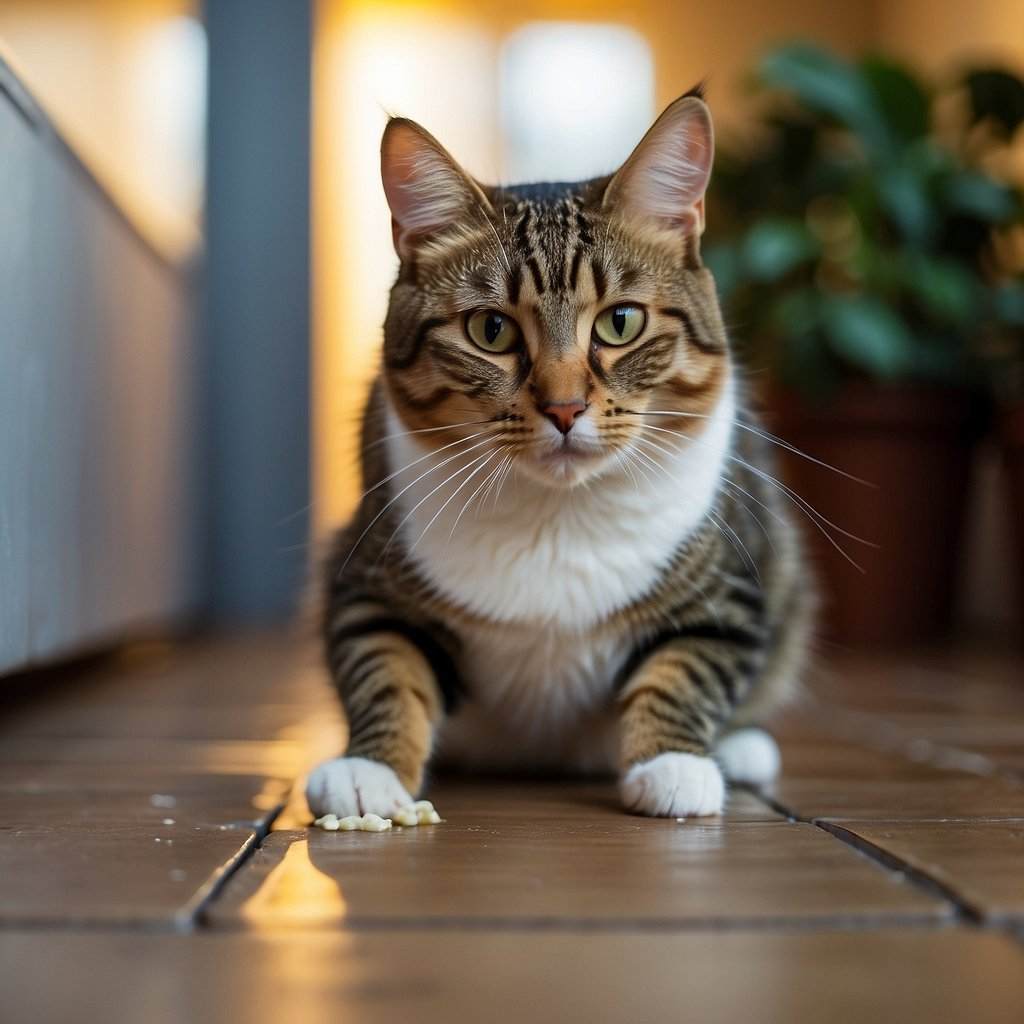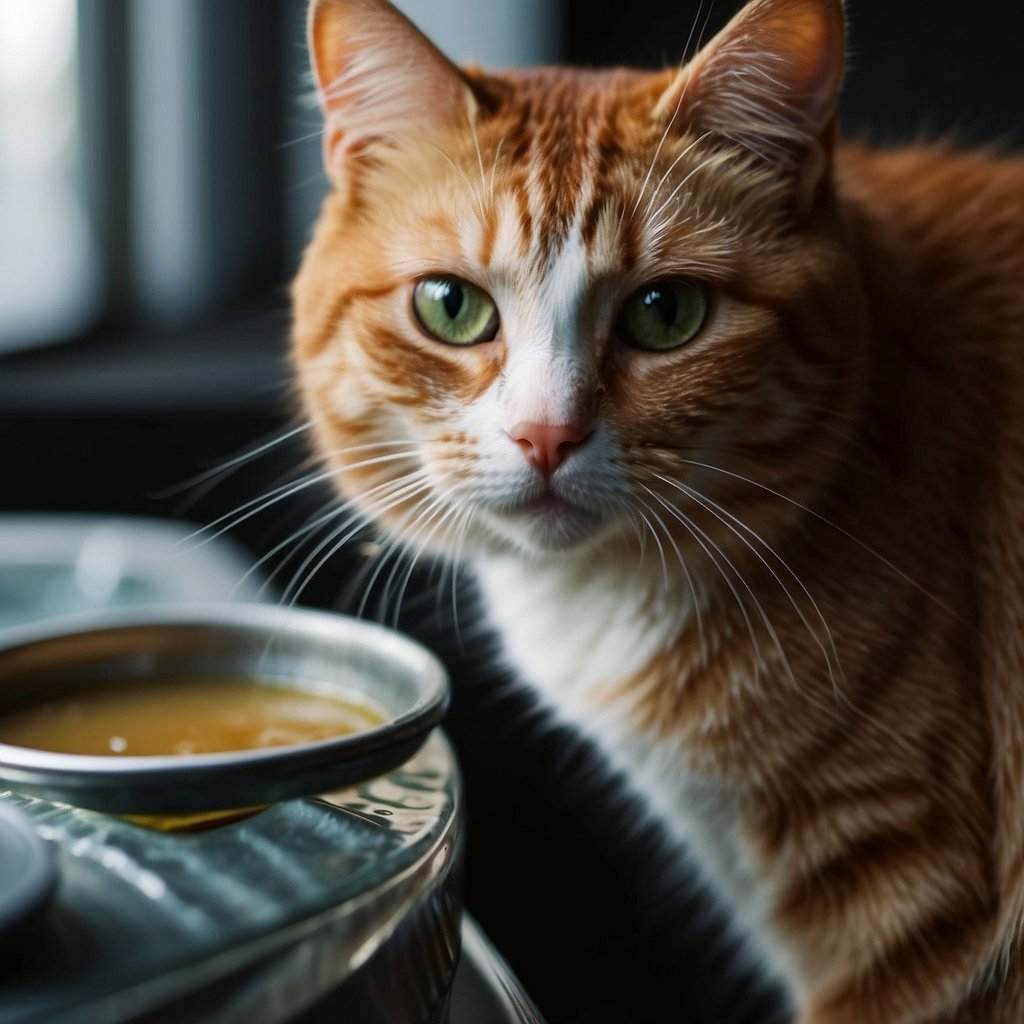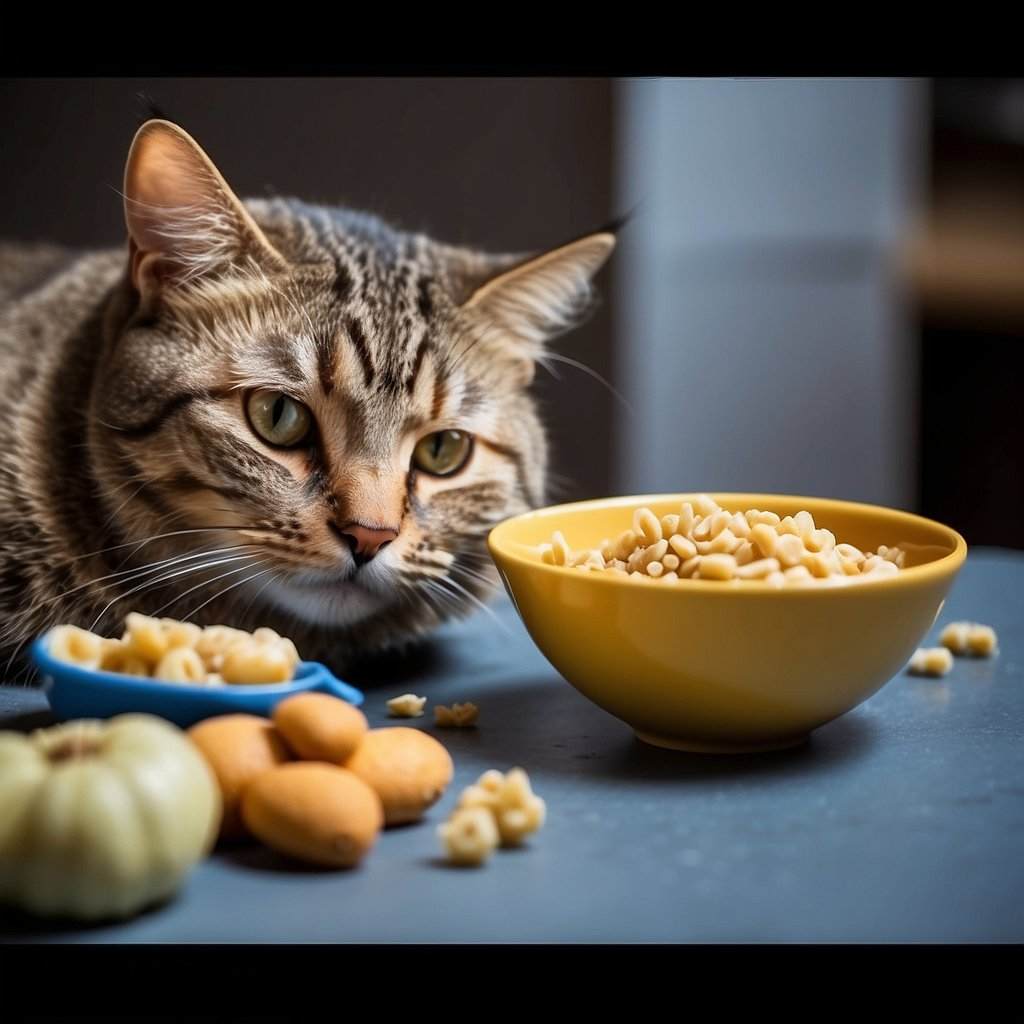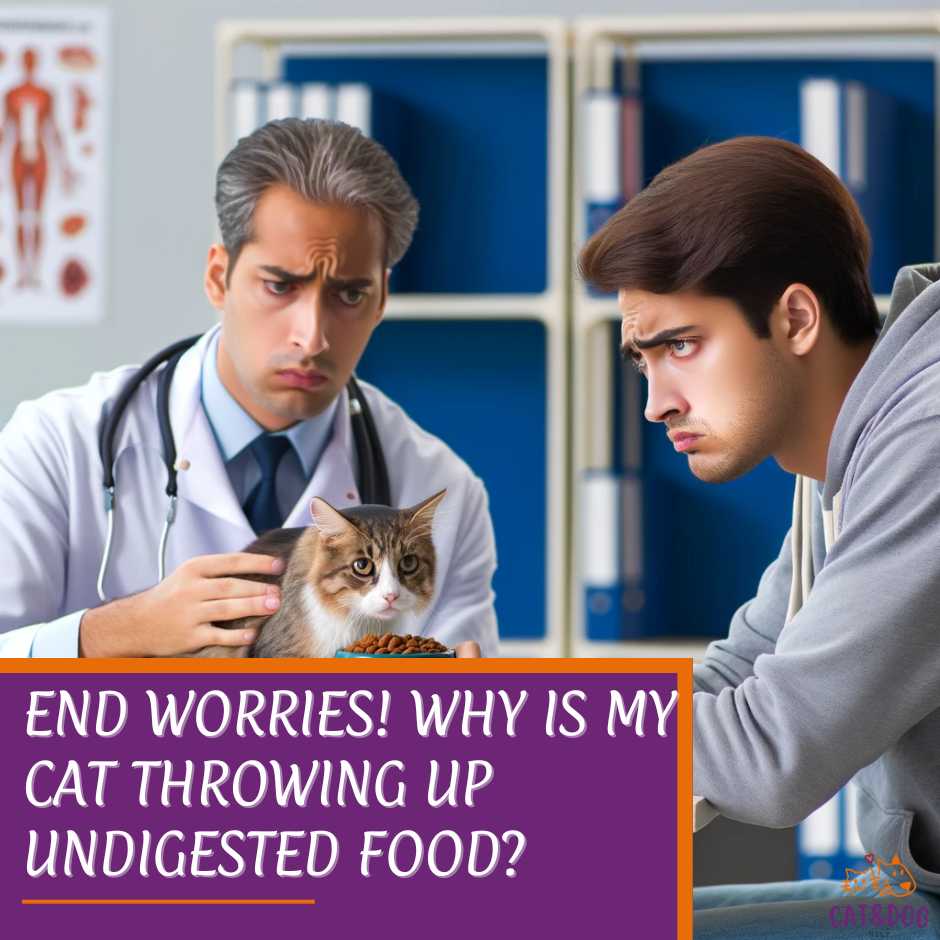You’ve just fed your furry friend their favorite meal, but moments later, you find undigested food on the floor. As a cat owner, this scenario can be both startling and concerning.
Cat vomiting is a common issue, but when the vomit consists of undigested food, it’s often a sign of regurgitation rather than true vomiting.
Distinguishing between the two can be crucial for your cat’s health. The main cause of vomiting undigested food is gorging.
If your cat eats too much, too quickly, the stomach becomes overstretched and puking occurs soon after feeding. To combat this, try to ensure your cat eats more slowly, or feeds little and often.

Regurgitation typically happens shortly after eating and doesn’t involve the usual signs of nausea or heaving that accompany vomiting.
Understanding why this happens is key to addressing the problem and ensuring the health and comfort of your cat.
This article aims to unravel the mystery behind why your cat is throwing up undigested food, using vet-approved information and insights.
By and large, if you see your cat throwing up undigested food, they are regurgitating, not vomiting. Regurgitation often occurs shortly after eating and is a more passive event.
Food will usually appear to just come out with no vocalizing, spasms, or contractions of the abdomen. Food usually maintains a cylindrical shape and appears undigested.
Sometimes the thrown-up food may have some mucus on it, but bile is usually absent.
The prevalence of this issue among cats is more common than you might think, making it a topic of significance for cat owners everywhere.
While the occasional incident might not be a cause for alarm, frequent occurrences warrant a closer look into your cat’s health and dietary habits.
Let’s explore the potential causes and find out when it’s time to be concerned, how to manage the issue, and ways to prevent it in the future.
If there is something that is irritating your cat, you should replace it with another type of food. Once again, your vet is the best person to ask for advice!
If you only give your cat dry food, canned food may be better for them in the long run (and has many advantageous health benefits.)
Key Takeaways
- Identifying regurgitation from true vomiting is vital for understanding your cat’s health.
- Frequent regurgitation of undigested food needs veterinary attention to rule out underlying conditions.
- Proper management and prevention can enhance your cat’s well-being, reducing instances of undigested food being thrown up.
Why Is My Cat Throwing Up Undigested Food?
Ever wondered why your furry friend is bringing up their dinner uninvited?
Well, cat vomiting can be as simple as a case of eating too fast or as complex as a metabolic disorder. Let’s unpack this messy subject together.
Causes of Vomiting in Cats:
- Dietary Indiscretion You know how cats are; they’ll try anything once, whether it’s good for them or not, so it is better to understand cat’s dietary need. Eating something they shouldn’t can upset their stomach. (1)
- Hairballs: Yes, those dreaded wads of fur can cause your cat to vomit.
- Eating Too Fast: When your cat inhales their food like it’s going out of style, it might just come back up.
- Food Intolerance: Just like us, cats can have allergies or a sensitive tummy when it comes to certain foods.
Distinguishing Between Vomiting and Regurgitation
Recognizing the difference between vomiting and regurgitation can give you clues about your cat’s health.
Vomiting involves retching and abdominal heaving — a bit like an unpleasant workout. It’s a forceful ejection of stomach contents and can happen quite a while after eating. (2)
Regurgitation, on the other furry paw, usually occurs shortly after a meal and without much fanfare. It’s like your cat just says “nope” and up comes that new diet you were trying. (3)
The food is often in tube shape, matching the esophagus, which didn’t quite make it to the stomach.
A quick tip: Keep an eye on how often your cat does their unfortunate food returns. Occasional mishaps? Maybe not a biggie. Frequent flyer? Time to chat with the vet.
Remember, our feline companions can’t tell us when they’re feeling off. It’s up to us to stay observant and seek professional advice when their vomiting seems more than just a random event.
Keep things comfortable and safe for your purring pal because we all know a happy cat means a happy home!
In-Depth Insights on Cat Vomiting
Hey there, have you ever wondered what’s going on when your furry friend starts to have that unmistakable retching noise?
Let me guide you through the physiological process of vomiting in cats. When your cat vomits, their body is trying to expel something irritating or indigestible. (4)
This can involve a complex coordination between the brain, stomach, and muscles.
- The Brain: The vomiting center in the brain gets signals from various parts of the body.
- The Stomach: Once the signal is received, the stomach muscles contract to reverse the usual direction of digestion.
- Muscle Coordination: With some diaphragm gymnastics for good measure, content comes back up the esophagus and out the mouth. (5)
Now, sometimes your cat’s vomiting could be more than just the usual suspects like speed-eating or a new food that didn’t sit well.
Let’s get into some unusual conditions that might be the culprits, shall we? Rarely, conditions like intestinal obstructions or pancreatitis might be to blame. These scenarios are no joke and require a vet’s expertise.
However, it’s important to note that the most common reasons for cats throwing up food but acting normally are not mentioned here.
One possible reason for a cat throwing up undigested food could be the ingestion of a foreign body in their gastrointestinal tract.
Rare Conditions:
- Thyroid Problems: Hyperthyroidism can speed things up inside, including how fast food moves, leading to puke fests. (6)
- Kidney Issues: Not fun for anyone, and they can upset the stomach balance.
- Neurological Disorders: These can disrupt the normal vomit-reflex control.
Remember, your cat can’t tell you what’s wrong, but their vomiting might be their way of saying, “Hey, check this out!”
Always keep an eye on the frequency and if in doubt, whisk them off to the vet for a thorough physical exam. And yes, a detailed chat with your vet wins over a web search any day!
If warranted, the initial tests are usually abdominal radiographs (aka X-rays) and blood work with a urinalysis.
X-rays can reveal abnormalities in organ size and shape, foreign bodies, tumors, constipation, and other abnormalities that the vet might not be able to assess with a physical exam.
When to Be Concerned

Hey there, noticing your feline friend bringing up their meal can be unsettling. It’s one thing for a kitty to cough up the occasional hairball, but undigested food?
Raises a few eyebrows, doesn’t it? Let’s sort through when these episodes deserve a vet visit.
- Frequent Vomiting: If you’re cleaning up more than the rare mess, this could be a flag.
- Changed Behavior: Is your furball acting differently? Hiding or less playful?
- Weight Loss: Keep an eye on the scale; dropping pounds isn’t normal for a healthy cat.
- Dehydration: Vomiting can lead to dehydration. Are they drinking enough water? (7)
Remember, a single event may not be an emergency, but a pattern surely warrants attention.
Veterinarians highlight that symptoms like lethargy, persistent vomiting, or refusal to eat should cue a vet visit. (8)
These signs could point to illnesses such as:
| Possible Conditions | Symptoms to Watch For |
| Kidney Disease | Increased thirst, urination |
| Liver Disease | Jaundice (yellowing eyes) |
| Parasites | Diarrhea, bloating |
| Food Sensitivities | Itchiness, skin irritations |
| Hyperthyroidism | Rapid heart rate, weight loss |
While stats and examples are sparse here, it’s critical to act on these red flags. Regurgitation often occurs soon after eating and is fairly passive.
Vomiting involves more retching and occurs after food has reached the stomach. Clear as day?
Tossing up undigested food occasionally isn’t a major worry—sometimes, kitties just eat too fast. But if you’re seeing it repeatedly or with other worrying symptoms mentioned, it’s time for a professional opinion.
Keep an eye out, and you’ll ensure that your furry companion stays purring and healthy for the long haul!
Treatment and Management

Has your furry friend been leaving surprise “gifts” of undigested kibble around the house? Not only is this concerning for you, but it’s not a fun time for your cat either. Let’s tackle this, shall we?
Consulting a Veterinarian
First things first, when you notice these uninvited “presents,” it’s time to chat with your vet. They’ve seen it all, and vomiting can be complicated. A professional diagnosis is key. Your vet might suggest:
- Bloodwork & Imaging: Getting to the root cause is essential. These tests can rule out or confirm issues like infections or obstructions.
- Medications: Based on the diagnosis, anti-nausea meds or antibiotics could be on the table.
Long-term Management Strategies
Now, for the home front. Managing your cat’s meals can go a long way. Here’s a little checklist to keep your kitty’s tummy happy:
- Measured Meals: Small, frequent meals can prevent overeating.
- Diet Overhaul: Sometimes a change in diet can help. Want a sensitive stomach-friendly recommendation? Your vet has the scoop.
Remember, it’s all about keeping your kitty healthy and your floors clean. Navigating the ocean of cat food options and health hacks doesn’t have to be a solo voyage—your vet’s your first mate.
Together, ensure your cat’s nine lives are as comfy as possible!
Preventive Measures and Advanced Care

Here’s how you can pivot from clean-up crew to preventative pet parent, with some TLC for those with more serious fuzzy belly concerns.
Slow and steady wins the race, right? The same goes for your feline friend’s eating habits. If your cat gobbles down its kibble faster than you can say “Meow,” consider a puzzle feeder to pace their eating.
Dealing with fur too fabulous? A grooming routine minimizes hairballs.
Now, here’s the daily to-do list for preventative cat care:
- Puzzle feeders: Puzzles or slow-feed bowls to reduce the speed of eating
- Regular grooming: Brushing to decrease hairball formation
- Quality diet: Balanced nutrients to aid digestion
- Freshwater: Ample hydration to support overall health
- Check-ups: Regular vet visits for wellness
Encountering a case of the kitty upchucks that won’t quit? It might be time for a deeper dive with the vet.
Chronic vomiters could need special diets, prescribed by a vet who’s seen it all, or medications controlling underlying catastrophes like pancreatitis.
In the tale of Tiger, the Tabby who turned tummy troubles around, his human followed vet advice to a T – including an elimination diet to pinpoint allergies.
Hours of vet reality shows? They’ve got nothing on the joy when Tiger stopped redecorating the floors!
Remember, each cat is as unique as a snowflake in a blizzard. Keep an eye on changes in behavior, weight, or appetite. The vet is your co-pilot in this journey.
With a blend of love, care, and medical savvy, your furball should be on the purr-fect path to wellness.
Quick Recap
Ever wondered “Why is my kitty bringing up their kibble?” Let’s help you crack the code! It could be as simple as your cat racing to the food bowl and gobbling up their meal faster than their tummy can handle.
Or maybe, just maybe, they’ve turned your living room rug into an impromptu toy and swallowed something they shouldn’t have. Whatever the case, let’s cover the bases:
Potential Causes:
- Overeating: Eating more than their tiny tummies can handle.
- Eating Too Quickly: Ingesting air and food, causes belly bloat.
- Regurgitation vs Vomiting: It’s not just semantics – there’s a difference! Regurgitation is food making a comeback before hitting the stomach, and vomiting is after digestion has begun.
- Foreign Objects: Your cat’s innate curiosity can lead them to ingest non-edible items.
When to Call the Vet:
- Persistent Vomiting: More than just a one-off event.
- Presence of Foreign Objects: Spot something unusual in the mess?
- Frequent Hairballs, Unusual Behavior, or Refusal to Eat: These signs need a vet’s attention.
Remember, a watchful eye can ensure your furry friend stays in purr-fect health. If this is a frequent occurrence, it’s time to ring up your vet and get to the bottom of it.
Tips for Proactive Care:
- Meal Management: Consider smaller, more frequent meals.
- Slow Feeder Bowls: To pace their enthusiasm at mealtime.
- Regular Check-Ups: Keeping up with vet visits is key!
Feeling savvy about sudden cat happenings? Your vigilance could be their ticket to a happy belly! Remember, we’re going for Happy Cat Olympics, not Speed Eating Championships!
Frequently Asked Questions

When your cat is bringing up more than just their latest interest in cardboard boxes—namely, their food—it’s natural to have questions.
Let’s dig right into what might be causing those tummy troubles and how you can help your feline friend.
How do I know if my cat’s vomiting is an emergency?
If your cat is experiencing repeated vomiting, showing signs of pain, lethargy, or if there’s blood present, it’s time to visit the vet post-haste.
Also, any change in behavior or appetite warrants a checkup.
Is occasional vomiting normal in cats?
Yes, an infrequent upchuck can be typical for cats, especially if they are hairball-prone. However, if your furball friend is vomiting often, it’s a good idea to consult your vet.
Can certain foods cause my cat to vomit?
Certainly! Just like us, cats can have sensitive stomachs or intolerances. Foods that are too rich or new types of treats can sometimes lead to a messy aftermath.
Is it normal for a cat to vomit yellow bile along with food?
Vomiting yellow bile could indicate that your cat’s stomach was empty except for bile, or there might be a more serious issue at play.
A vet visit is appropriate to rule out any concerns.
How can I prevent my cat from vomiting after meals?
Try these steps: Serve smaller, more frequent meals, ensure your cat eats slowly, and keep them calm post-dinner.
Sometimes, a puzzle feeder can be a fun solution to slow down speedy eaters.
Should I change my cat’s diet if it vomits often?
If your cat has turned into a bit of a regurgitation regular, it’s wise to discuss dietary changes with your vet.
They can advise on the best food options to reduce your cat’s gastric distress
- The Ultimate Overview to Actual Cash Gambling Establishments - July 1, 2025


